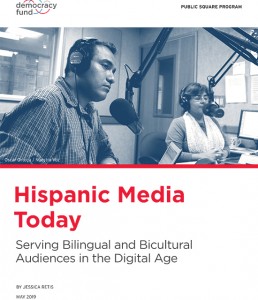CSUN Prof’s Study Examines the State of US Hispanic Media in the Digital Age
Spanish-language and bilingual media in the United States need to understand the history of Hispanic media in the U.S., and appreciate the country’s complex and diverse Hispanic population if they are going to survive the digital age, according to a new study of the state of the industry by California State University, Northridge associate professor of journalism Jessica Retis.

Jessica Retis
Retis’ report, “Hispanic Media Today: Serving Bilingual and Bicultural Audiences in the Digital Age,” was published last month by the nonprofit Democracy Fund. In it, Retis reviews the evolution of U.S. Spanish-language newspapers, radio and television, and outlines the challenges she sees facing Hispanic media in the digital age.
“In order to understand the current situation with Hispanic media, you need to go back in time, more than 200 years,” she said. “In doing so, we cannot talk about one homogeneous group of Hispanic media because there is no one homogeneous group of Latinos in the U.S. We are very diverse ethnically, as well as in the languages we speak, from Spanish to Spanglish.”
It’s that complexity of the Latino population in the United States, that adds to the challenges faced by the media that serves Spanish-speaking and bilingual Americans, she said, adding that she used the words “Hispanic,” “Latino” and “Latinx” interchangeably in her report because of what they mean in different regions and to different generations across the country.
Not only, she said, is the Hispanic media struggling to find their audiences as more people turn to social media and the internet for their news, they also are competing with English-language media for their audience as that media — responding to the United States’ increasingly diverse demographics — increase their Spanish-language and bilingual offerings.
If Hispanic media are going to survive the transition to the digital age, Retis said, they are going to have to find ways to fund professional development opportunities to support American-born, Spanish-language journalists; establish a bilingual news portal to translate and bridge across communities; and provide support for citizen oversight of Hispanic media to be a community resource against hate.
“The changes taking place within the Spanish-language and Latinx-oriented media have happened in parallel to the demographic shifts in the country and a corresponding rise of anti-immigrant and anti-Hispanic sentiment,” Retis said. “Spanish-language media are important resources for information and self-representation, and can be an important resource for pushing back against anti-immigrant narratives that pervade some mainstream media.”
 Retis said Spanish-language media in the United States can trace their roots to the founding of El Misisipi, a four-page biweekly and bilingual newspaper in New Orleans in 1808. Though the publication folded two years later, more than 100 Spanish-language papers were being published in the Southwest by 1900.
Retis said Spanish-language media in the United States can trace their roots to the founding of El Misisipi, a four-page biweekly and bilingual newspaper in New Orleans in 1808. Though the publication folded two years later, more than 100 Spanish-language papers were being published in the Southwest by 1900.
Those publications owned by English-language papers sometimes used their Spanish-language versions to exert social control over the community’s Spanish-speaking populations, Retis said. Those started by the Spanish-speaking community members were often vehicles of activism that exposed and denounced the oppression their readers faced. Still others, she said, were created to record events, interests and thoughts of Hispanic communities, “but also asserting the importance of a strong cultural identity.”
By the mid-1990s to early 2000s, the circulations of Spanish-language newspapers more than tripled, while English-language newspapers experienced an 11 percent decline, Retis said.
“In more recent years, the audience for Spanish-language newspapers has been declining,” she said. “Between 2014 and 2017, the average Monday through Friday circulation of Spanish-language newspapers declined markedly for the top daily papers. Like the larger news media industry, Spanish-language press has faced the transition to the digital era, while simultaneously experiencing the consolidation of news media conglomerates.”
When it comes to Hispanic broadcast media — radio and television — the situation is not quite so tumultuous, Retis said, noting that Hispanic television in particular has become “a space of self-representation, providing information on Latinx communities’ interest on issues such as immigration, politics, health, education and culture.
“It has also become a source of information and entertainment produced for and imported from Latin American countries,” she said. “Fifty years ago, Spanish-language television did not receive the attention of commercial mainstream media investors and advertisers. But similar to Spanish-language radio, the growing Latinx audience during the late 1980s and 1990s resulted in remarkable interest in investing in Latinx television, particularly when the overall Spanish-language TV audience growth surpassed that of the U.S. mainstream media.”
As the 2020s approach, the issue for all three media is staying relevant and accessible to continually growing, evolving and diverse audiences, including a younger Latinx generation that relies on the internet for their news.
Retis said Spanish-language and bilingual media in the United States face several key challenges. Among them are the limited efforts to archive Spanish-language media in any format.
“This puts Hispanic media at a disadvantage in terms of not only research, but also the ability of journalists and audiences to return to stories for follow-up or for sharing,” she said.
Also, as in other media sectors, Hispanic media is facing significant financial challenges, Retis said.
“In interviews with several Hispanic journalists, frustration about having to do more with fewer resources was a recurring theme,” she said. “Year by year, they have witnessed the shrinking of their newsrooms, if they have not already been laid off. “Most of them expresses their frustration that quality has been replaced with quantity.”
One of the biggest challenges journalists working for Hispanic media face is the complex diversity of the Latino population in the United States, Retis said.
“The histories and cultures of Hispanic Americans can differ significantly from region to region,” she said. “Although Hispanic journalists know the culture of their families’ countries of origin, as well as their local communities in the United States, the growing mobility of job opportunities also demands a rapid adaptation to local audiences different from their own history and culture.”

 experience
experience